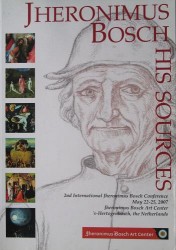
Colenbrander 2010
“Exotica” (Herman Colenbrander) 2010
[in: Eric De Bruyn and Jos Koldeweij (eds.), Jheronimus Bosch. His Sources. 2nd International Jheronimus Bosch Conference, May 22-25, 2007, Jheronimus Bosch Art Center, ’s-Hertogenbosch, The Netherlands. Jheronimus Bosch Art Center, ’s-Hertogenbosch, 2010, pp. 73-89]
In the past a number of engravings, book illustrations and drawings have already been indicated as possible sources for the exotic plants and animals in Bosch’s Garden of Delights. For the palm tree, the dragon tree, the elephant, the giraffe, the dromedary, the deer, the antelopes and the strange animal that calls to mind an Indian goat written sources do not suffice, but the figurative examples that could have inspired Bosch, are not very satisfactory either. In rendering the fauna and flora Bosch did not follow nature exactly, apparently he even rendered them rather fanciful. The strawberry, the madroño and the dragon tree are clearly recognizable, though. The madroño is the fruit of the strawberry tree (arbutus unedo) which grows only in the Iberian Peninsula. The dragon tree was not endemic to Brabant either: it is native only on the Canary Islands and Madeira, but as early as 1494 examples grown from seed were seen in Lisbon and Seville. These two examples indicate that the region from which Bosch drew his inspiration was not located in Italy and the Middle East, but in the western part of the Mediterranean, especially the Iberian Peninsula. The question is: in what way did Bosch acquire his knowledge of these and other exotic elements in the Garden?
In the first place it should be reminded that ’s-Hertogenbosch is not so far away from Antwerp which was then one of the most important harbours in the north and maintained intensive trade relations with southern Europe. For his examples Bosch may have relied on pictures and specimens brought to Antwerp by travellers and ships from Portugal, Spain, the Canary Islands, the Azores and the Indies. The possibility that Bosch himself travelled to the Iberian Peninsula cannot be ruled out either. However, in this article Colenbrander is considering another channel through which Bosch might have acquired his knowledge of the exotics in the Garden: the court in Brussels.
Bosch was no stranger to the court in Brussels. Philip the Fair, as duke of Brabant, visited ’s-Hertogenbosch several times. Bosch also had relations with Hendrik III of Nassau, one of the leading knights at the court, in whose palace in Brussels the Garden hung. Although the only proof we have is the commission of a Last Judgment by Philip the Fair, others at the court may have followed his example and it is plausible that Bosch became acquainted with the exotics through the channel of the court as it travelled to Spain twice for fairly extended periods. The name of Bosch does not occur in the lists of the persons participating in these journeys, but the possibility he joined them cannot be ruled out. He also may have been in the position (both in Spain and in Brussels) to see the wonderful objects the explorers brought back from the Indies, presented to the king and exhibited at the court. These exotics must have made an immense impression, but apparently they left no traces in European art and were not used as examples for artists. However, it is against the background of the unceasing flow of wild rumours and fantastic tales about the new discoveries of paradisiacal places and the treasures of gold, pearls, wonderful objects, unknown humans, animals, plants and fruits which were brought to Europe, that we have to see the Garden.
One of these fantastic tales is the discovery of the so-called Fountain of Youth on the island of Bimini by the Spanish conquistador Juan Ponce de Léon in 1512. It was included and illustrated in the Atlas Miller of about 1519 (see the colour illustration on page 80). Examples like these recall Bosch’s Garden and demonstrate that Bosch was familiar with current concepts of exotic places. Whether Bosch himself travelled abroad cannot be determined. However, Slatkes and Van Dijck have pointed out that from 1504 on Bosch was called ‘Jeronimo’ instead of ‘Jheronimus’ by his fellows of the Brotherhood of Our Lady. According to Slatkes and Van Dijck this could mean Bosch travelled to Italy, but Colenbrander states that in this case he would have been called ‘Girolamo’. ‘Jeronimo’ is not the Italian but the Spanish or Portuguese spelling of ‘Jheronimus’.
Colenbrander locates the Fountain of Youth in St Augustine, Florida where there is indeed a Fountain of Youth National Archaeological Park. However, Bimini is a group of islands some 80 km east of Miami Beach. On one of these islands (North Bimini) there is still a therapeutic spring today (source: Wikipedia). Anyhow, the discovery of this so-called Fountain of Youth in 1512/13 seems to be dated somewhat late to have influenced Bosch’s Garden and the Atlas Miller was produced around 1519, whereas Bosch died in 1516. Of course, Colenbrander does not want to claim that Bosch knew the Bimini fountain, he only wants to point out that Bosch may have been influenced by similar tales about similar exotic places, objects, plants and animals.
[explicit]